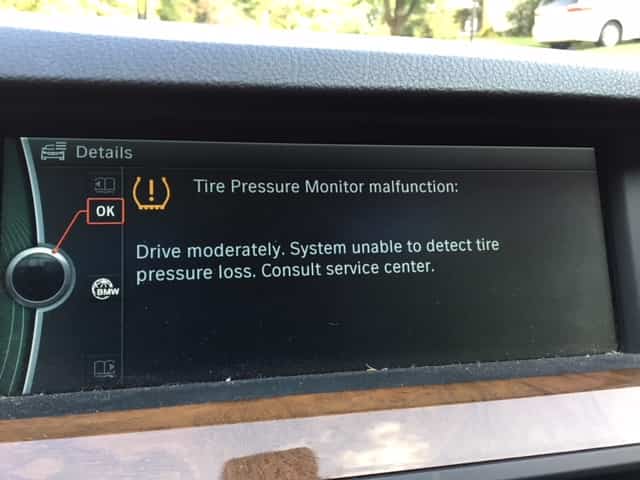BMW is known for its style, high performance, and cutting-edge technology. One of these technologies is the TPM, which measures your vehicle’s tire pressure. But as with any other technology, the TPM(Tire Pressure Monitoring) technology is also prone to malfunction.
I know while driving your BMW on a beautiful sunny day suddenly you got a TPM Malfunction on your BMW dashboard, how frustrating. And you may be wondering what is this TPM malfunction? What does it do? what is the reason behind this malfunction? how to fix it? then take a deep breath, cause in this blog we’re gonna discuss these issues and their solutions with a step-by-step guide.
What is the TPM on BMW?
The TPM(Tire Pressure Monitoring) or in German Reifen Druck Kontrolle is a very crucial electronic system, which increases your driving experience. This system was introduced in all vehicles manufactured after 2007.
The TPM system consists of different sensors, transmitters, and a control module which is used to measure the tire pressure. Its main purpose is to check the tire pressure in each tire occasionally and send the data to the ECU/ECM.
If the air is less than 20% below the recommended level, then this system will send an alert to the driver by showing a dashboard light or a warning error message. On the other hand, the TPM system light indicates any fault in the TPM system. And, the warning error message could vary depending on your car model.
The old days are long gone, when you have to check your tires flat or any other problems by yourself or guess the tire pressure. Now your car does this for you, where the TPM system senses your tires and, gives you an alert about the tire pressure or any problems in it.
How does the BMW TPMS system work?
There are TPMS sensors available in every tire, which monitor the tires and send information about the tire pressure to the vehicle’s onboard computer. And when the air pressure is too low this system notifies the driver.
The ideal tire pressure is typically between 32-36 PSI, and in low-profile tires, this is about 45 PSI. In this range, you’ll experience a better driving experience, better fuel economy, and a longer tire life.
And, the alert notification to the driver is conveyed through the iDrive system, where the driver can easily check the tire pressure individually. This provides more convenience to the driver and also acts as a safety feature by ensuring an optimized driving experience.
Read More: BMW 328i Head Gasket Replacement Cost
What Is TPM Malfunction On BMW?

As you just got know about the TPM system, sometimes there can be some malfunction, let’s discuss those. When your TPM system is malfunctioning you’ll see a warning message in your dashboard. which will flash a text like “Tire Pressure Monitor (TPM) malfunction” or “TPM inactive” in your dashboard, you can see different types of error messages according to your BMW model.
And when the system is malfunctioning it will give you fault information or complete failure to give you any information about the tire pressure.
This usually occurs when the TPM sensors are not monitoring the air pressure or the central control unit malfunctions which includes the RDC, TPM, and TPMS receiver.
Reset The BMW TPM warning
Some of you may have just got a TPM warning for low air pressure on your tires, So don’t worry. That can be solved very easily and also resetting the warning.
Resetting a TPM warning is a work of a few minutes, so just read along and you’ll know how here:-
- First inflate your tires to a recommended level, usually 36 PSI.
- After inflating the tires, we’re gonna reset the warning.
- With the help of the iDrive knob, click on vehicle settings.
- Then with the Drive knob scroll down to the vehicle tires.
- Now select the TPM menu by rotating the iDrive knob.
- Here select the Reset option and press the iDrive knob.
- Now select yes, and the status should show “Reseting TPM”.
- Now take a little drive, and it will show “TPM Active”.
By performing this method you can simply reset the TPM warning from your iDrive screen.
Common Reasons For TPM Malfunction on BMW
Malfunctions in the TPM system can be caused by many reasons, which is important to know before fixing the malfunction. The warning error doesn’t give much information about the malfunction, so we’ve to find out the reason by ourselves.
Here are the most common reasons for the TPM malfunctioning:-
Defective TPM (RDC) Sensors
The main job of the TPM sensors is to monitor the tires and send information to the TPM control module. But sometimes one or more sensors can fail and send wrong information to the control module, or no information at all. Which eventually flags this issue in your iDrive as the “Tire Pressure Monitor (TPM) Malfunction”.
The sensors run on lithium-ion batteries and have a lifespan of about 10 years. And the batteries drain with time, which is a major reason for the TPM sensor’s failure.
Another reason can be mechanical damage which happens during the fitment of tires. To fix this issue you have to replace the sensors, for that, you’ll need to contact your dealership service center or any certified Auto Shop.
TPM Transmitter Failure
Older vehicles or generation 1 or 2 TPM systems use the transmitter. The transmitter is another important component in the TPM system, which is situated in the tires along with sensors. These transmitters get the signals from the sensors and transfer them to the control module. The transmitters can fail due to many reasons which can break the communication process.
This will eventually lead to the TPM system malfunctioning.
Damaged TPM Fuse
The TPM fuse is also an important component in the TPM/RDC system. Which can be burned if the control unit shorts out. So, you should check your TPM fuse to find any damage.
You can find this fuse in the junction box behind the glove compartment, or contact any professional to do this for you.
Water Damage
Newer models or generation 3 or later TPM systems are mounted in the front chassis for a more simplified system. Without transmitters in the wheel, there are only TPM sensors and a control unit with an integrated antenna.
Mounting this system in the front chassis can expose all the components. And the water can easily enter the casing, and cause massive damage to the electronic components.
The moisture in the electronic components can cause corrosion, as a result, the entire TPM system could need to be replaced. But if you’re lucky enough, then only cleaning the corrosion can solve your problem. If you’re a DIY guy you could easily perform this task otherwise hiring a professional will always do the work.
Faulty Wiring
The wiring which connects the sensors with the control unit can become faulty due to any wear and tear, or any other factors. A short circuit or damaged wiring can easily disrupt the communication between the TPM systems components, which will eventually cause a malfunction.
There can be some other reasons which can cause the malfunctions like software glitch etc.
Read More: Are BMW Rear Wheel Drive?
how to fix TPM malfunction BMW?
Now you know the reasons behind the TPM malfunctioning on your BMW, and now wondering about the solution. Then hang on with me, we’ll get right into it.
Can you Fix a BMW TPM Yourself?
There can be many different minor issues that can cause a TPM system to malfunction, which can be easily fixed by you.
And, especially if you are a DIY person like me, then you’ll be able to fix any basic problem, which is causing the malfunction.
However, if you’re TPM system is sending incorrect data, or not working properly, then it should be resolved by a professional. We’re gonna share with you some common issues that you can fix by yourself.
Fixing TPM Malfunction on BMW
To fix a malfunction you have to first identify the root cause, to find out the root cause you have to make a diagnosis. To do that you could use a BMW OBD-II scanner to get detailed information about the error. And, you can also perform a visual inspection of your vehicle. Check the TPM system for any wiring damage, corrosion, or fuse issues.
Tire Pressure Issue
As stated earlier the warning sign can be a reason to inform you about the low air pressure on the vehicle. So, first, do a basic task that can be a solution for many.
- First, inflate all the tires at a recommended level.
- Then reset the warning error using the guide “Reset The BMW TPM warning” described above.
- Now drive a few times and if the warning doesn’t come out, it was just a low tire pressure. But if the warning sign came again then it’s more than low tire pressure.
You can again check your tire pressure to see if any tire is flat. If it is flat you can go to any auto shop and repair or replace the tire. In this case, the TPM is fine. But, if no flat is detected then follow along.
Replace TPM Sensors
If all the tires are working fine, then the common issue is the TPM sensors, whose battery has a lifespan of 7-10 years. If the batteries are drained it will cause a malfunction.
And, the batteries cannot be charged or replaced, you have to replace the TPM sensors. The replacement process of the TPM sensors can be tough for you so it is always recommended to consult with your dealership service center or any trusted auto shop.
Because to replace the senses you’ll need many tools and scanners, so, it is better to be done by an expert.
Wiring Issue
If your sensors are fine, then the next thing you should do is check your TPMS wirings for any damage. If you find any damage you should get it replaced ASAP.
Update Your Software
Sometimes outdated software shows glitches, which can be very confusing, however, if you update the software any malfunction glitches will clean up. It is very necessary to keep your software up to date.
If you can’t update your BMW software, you can visit your dealership or any certified auto shop they will do that for you.
Professional Diagnosis
If you’ve tried and tested your vehicle and couldn’t find any issue or found one and fixed it, but the warning sign still persists, then it is time you go to a professional. They have more advanced tools, scanners, and experience, and they will easily find any issue and resolve it.
The TPM system can be complex, it is better to be fixed by a professional technician.
When To Visit the Dealership
After using the guide above you have replaced or fixed the necessary components, but the warning sign still persists. You’ve also changed the sensors and have a good tire, but the warning sign isn’t going away.
And you’ve shown your vehicle to a certified auto shop but they also weren’t able to solve the TPM malfunction. Then it is clearly a manufacturing error.
In many BMW forums people complain about the same issue, where their vehicle has a manufacturing TPM system error. After doing many services their TPM malfunction error doesn’t go away.
So, it is better to visit the BMW dealership now, they will diagnose and if they can solve the issue then it’s fine. But if they diagnose any manufacturing error, they will replace the full TPM system.
How Much Does it Cost to Fix a BMW TPM Malfunction?
Fixing the TPMS malfunction doesn’t cost much, depending on the particular sensors it should cost you around $150-$450 including labor costs. The cost could go a bit higher if you need programmed sensors, but still, it is an inexpensive repair.
Can I Drive with a TPM Malfunction on BMW?
Yes, you can drive your BMW with a TPM malfunction, however it is not advised. If your tire pressure is too low or have flat tires you could still drive for 200 miles at 55 mph.
But when driving with low air pressure on one tire will pull the vehicle in one direction. This will cause bad control over your vehicle, and it can be very dangerous due to the increased risk of accidents.
And, you should never drive with a flat tire, cause it can damage the tire and also the wheel, then you have to replace the tire.
So, that’s why I would never recommend you to drive with a TPM malfunction, to drive first check if all the tires have recommended air pressure. And if the air pressure is good then you can ignore the TPM malfunction and drive, cause it would mean the TPM system has failed.
Conclusions
The TPM malfunction error can be very frustrating, but it is easily solvable without any massive repair cost.
However the TPM malfunction is a very rare case, but if it occurs the main problem should be related to the sensors, transmitter, or the control module. So, diagnose it properly by using the above guide, or get a professional help to do that. Once you get the issue get it fixed by a professional technician as soon as possible.
I hope now you know a lot about the TPM system malfunction and you can DIY your solution.
FAQ
Many causes can trigger TPMS malfunction like faulty Tire Pressure Monitor sensors, damaged TPM fuse, Faulty Wiring, etc.
The TPM or Tire Pressure Montier system monitors tire pressures and warns if any of the tires have low pressure. The TPM sensor monitors all five tires (if the fifth tire has a sensor) air pressure.
The TPM fault is when the TPM sensors or the TPM system is malfunctioned and it cannot monitor the tire pressures properly.
Image Credit: Bimmerpost Forum
Related Posts:
BMW Passenger Restraint System Malfunction: Causes & Fixes
BMW 328i Head Gasket Replacement Cost: Fully Explained




